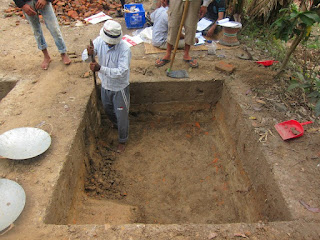 |
| Excavation at Vikrampur, Bangladesh |
One of the
country’s leading archaeologists has described the vanished city of Vikrampur,
at the junction of many rivers that flow into the tidal waters of the Delta, as
being represented by ‘over 17 Unions(parishes), you put your spade in the
ground and find 18 inches of mud, then brick’.
 |
| Digging through mud and brick to unearth Bangladesh's History |
Clearly this
ancient city, capitol of a large area of historic Bengal, under the benign
influence of Buddhist and Hindu kings, then Islamic overlords, was once
something of a booming city and trading centre.
Little of
which any casual search on Google (who insist on the interchangeable
Bhikrampur) would reveal.
One major
fact in the city’s history, however, does stand out. That it was both the
birthplace and home of Atish Dipankar, widely known in Tibet as ‘The Second
Buddha’.
 |
| Pagoda built by the People's Republic of China to recognize the contributions of Atish Dipankar |
The
Government of the People’s Republic of China have built a Pagoda and Auditorium
to commemorate Dipankar’s ‘Social work in China’ close by the present
excavation site in Vikrampur.
In the
middle of the 11th Century, it is said that, whilst principal of a
large Vihara in Vikrampur with over 8,000 students from across the Buddhist
world including China, Japan, Cambodia, Sumatra, Sri Lanka and Thailand,
Dipankar was invited by the King of Tibet to go to travel to his kingdom and
help restore the Buddhist faith that had fallen into decay.
 |
| Could this be the great Vihara of Atish Dipankar? |
That he
succeeded in this restoration is clear from his nickname as well as Tibet’s current
status as the home of Tantra and Yoga, both elements of the liberal Mahayana
School of Buddhism. In fact, the
Mahayana School probably developed in the great monastic and teaching tradition
of the more than 350 Vihara whose remains are scattered through Bangladesh, as
is one of the few Ashokan Pillars marking where the Buddha himself taught.
 |
| Archaeologists work to unearth the history of this fascinating site. |
Archaeologists
in Bangladesh are presently engaged in slowly, lacking as they do many of the
modern resources available to the science around the world, excavating what
seems to be a huge vihara not far from the site identified as the birthplace of
Dipankar.
With solid
brick walls, appearing to be the result of at least two periods of development,
dating prior to the 11th Century and measuring in many cases more than
3 or 4 feet thick, as well as some small pieces of Basalt sculpture and a great
deal of pottery yet to be evaluated, archaeologists believe they may have finally
found Dipankar’s great vihara.
 |
| Excavation at Vikrampur is slow work thanks to a lack of modern tools |
However, as
noticed at Mainamati and many other such sites, vihara come ‘not as single
spies’ but in fact by the dozen. This
excavation then may just be the start of a lengthy process. With so little
resource and so much to do, compounded by the exponential rate of urban development
in this nation with a rapidly growing population, there is always the risk that
much of this great history will never again see the light of day.
 |
| Categorizing bits of pottery and brick found at Vikrampur, Bangladesh. |
An
interesting addition to this site, which may well be built over fairly soon, is
what appears to be the remains of, perhaps, a Jain Temple, adjoining a nearby
British Period farmhouse.



No comments:
Post a Comment